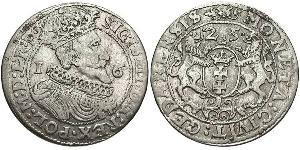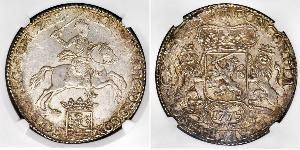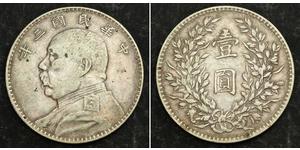(sold for $111.0)
1565, Vatican, Pope Pius IV de Medici. Scarce Silver Bianco Coin. R!
Mint Place: Bologna
Mint Period: 1559-1565
Mint Master: Mazzeo Mazzei
Denomination: Bianco (½ Lira)
Reference: CNI 10, Muntoni 70, Berman 1076. R!
Condition: Lightly ragged rim, dark oxidation spots and rusty incrustations, cleaned, otherwise a nice VF!
Diameter: 30mm
Material: Silver
Weight: 4.58gm
Obverse: Pope Pius IV, wearing cap and cope right.
Legend: · PIVS · IIIII · PONT · MAX ·
Reverse: Lion rampart left, holding banner.
Legend: · BONONIA · MATER · STVDIORVM ·
Authenticity unconditionally guaraneed.
Pope Pius IV (31 March 1499 – 9 December 1565), born Giovanni Angelo Medici, was Pope from 1559 to 1565. He is notable for presiding over the culmination of the Council of Trent.
Giovanni Angelo Medici was born of humble parentage in Milan, distantly related to the Medicis of Florence. His early career connects itself in some measure with the rise of his elder brother, Gian Giacomo Medici, from the position of a mere bravo to that of Marchese di Marignano.
After studying at Bologna and acquiring a reputation as a jurist, he went in 1527 to Rome, and as the favourite of Pope Paul III was rapidly promoted to the governorship of several towns, the archbishopric of Ragusa, the vice-legateship of Bologna, and in April 1549, to the cardinalate. On the death of Pope Paul IV, he was elected Pope Pius IV on 25 December 1559, and installed on 6 January 1560. His first public acts of importance were to grant a general pardon to the participators in the riot which had closed the previous pontificate, and to bring to trial the nephews of his predecessor, of whom Cardinal Carlo Carafa was strangled, and Duke Giovanni Carafa of Paliano, with his nearest connections, beheaded.
On 18 January 1562 the council of Trent, which had been suspended by Pope Julius III, was opened for the third time. Great skill and caution were necessary to effect a settlement of the questions before it, inasmuch as the three principal nations taking part in it, though at issue with regard to their own special demands, were prepared to unite their forces against the demands of Rome. Pius IV, however, aided by Cardinal Morone and Charles Borromeo, proved himself equal to the emergency, and by judicious management – and concession – brought the council to a termination satisfactory to the disputants and favourable to the pontifical authority. Its definitions and decrees were confirmed by a papal bull dated 26 January 1564; and, though they were received with certain limitations by France and Spain, the famous Creed of Pius IV, or Tridentine Creed, became an authoritative expression of the Catholic faith. The more marked manifestations of stringency during his pontificate appear to have been prompted rather than spontaneous, his personal character inclining him to moderation and ease.
Thus, a warning, issued in 1564, summoning Jeanne d'Albret, the Queen of Navarre, before the Inquisition on a charge of Calvinism, was withdrawn by him in deference to the indignant protest of Charles IX of France. In the same year he published a bull granting the use of the cup to the laity of Austria and Bohemia. One of his strongest passions appears to have been that of building, which somewhat strained his resources in contributing to the adornment of Rome (including the new Porta Pia and Via Pia, named after him, and the northern extension (Addizione) of the rione of Borgo), and in carrying on the work of restoration, erection, and fortification in various parts of the ecclesiastical states.
On the other hands, others bemoaned the austere Roman culture during his papacy; Giorgio Vasari in 1567 spoke of a time when "the grandeurs of this place reduced by stinginess of living, dullness of dress, and simplicity in so many things; Rome is fallen into much misery, and if it is true that Christ loved poverty and the City wishes to follow in his steps she will quickly become beggarly...".
A conspiracy against Pius IV, headed by Benedetto Accolti the Younger, the son of a cardinal, was discovered and crushed in 1565.
Pius IV was a nepotist. Among the relatives he favoured, the main figure is that of Carlo Borromeo. Under his reign Michelangelo re-built the basilica of Santa Maria degli Angeli (in the Diocletian's Baths) and the eponymous Villa Pia, now known as Casina Pio IV and headquarters of the Pontifical Academy of Sciences, was designed by Pirro Ligorio in the Vatican Gardens.
He died on 9 December 1565, and was buried in Santa Maria degli Angeli. His successor was Pius V.
He is generally believed to be the first pope to have died leaving in pectore cardinals unpublished.
Katherine Rinne said in her book Waters of Rome that Pius IV also ordered public construction to improve water supply of the Rome city.

|
Posted by:
anonymous 2014-02-11 |
1 Yuan / 1 Dollar China Silver Yuan Shikai (1859 - 1916)
group has 394 coins / 380 prices
⇑
1000 Reis Kingdom of Portugal (1139-1910) Silver Carlos I of ...
group has 12 coins / 10 prices
⇑

















-300-150-BZEKbzbifdQAAAFLyHbk0KRF.jpg)






